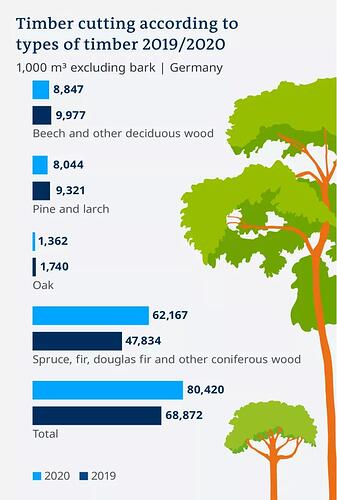The German forest is almost dying. Is it the fault of China and the United States?
2022-08-19 02:33 HKT
From August 5th to 6th, the second German National Forest Summit was held at the Wöllerben Forest College in Western Germany. In this second national forest summit in Germany, the theme of this conference is “Waldsterben 2.0” (Forest Recession) to discuss how to manage the state of Germany’s forests in the face of the climate crisis and global trade demands.
German timber crisis triggered by global trade
The price of construction timber in Germany has once risen to twice that of last year, and the price of individual materials such as roof slats has even reached three times that of the same period last year. This phenomenon of skyrocketing prices is mainly caused by the shortage of wood in the German domestic market.
There are many situations that cause wood shortages, but the most important factor is that German domestic wood is exported in large quantities. Among them, the largest increase in exports is China and the United States. For the whole year of 2020, German log exports were about 12.7 million cubic meters, valued at 845 million euros, a year-on-year increase of 42.6%. Half of the exported wood (50.6%, about 6.4 million cubic meters) was shipped to China. Due to China’s proper epidemic control measures and the strong domestic economic recovery, China’s import demand for logs and timber leads the rest of the world. Foreign media once predicted that China’s timber imports this year could achieve double-digit growth, and China has become the largest market for German log exports.
The United States has turned to Europe to buy wood due to forest fires and trade disputes with Canada and other countries in recent years. Germany is the largest timber producer in the EU. German timber exports to the United States increased by 42% last year. The price of German timber purchased by Chinese and American companies will be significantly higher than that of local German buyers, which has further contributed to the surge in German timber exports.
Continuous natural disasters have caused forests to die, how to save them?
In 2020, 8.04 million cubic meters of wood will be logged in Germany. This data has become the highest logging data in a historical year since the reunification of the two Germanys (1990). For the monoculture spruce coniferous forest, which occupies one-third of Germany’s forest area, forest fires are not a problem. On the contrary, the bark beetle plague thrives in the dry and hot weather caused by global warming, and German forests have become the victims of the bark beetle disaster.
The growth in demand for timber exports from Germany has been synchronized with the record domestic logging. It is currently foreseeable that if the German government no longer implements measures to control German domestic timber logging and export control, and does not implement crisis control over German forests, there will be irreversible effects in the future.
The nature of German forests makes them extremely vulnerable to climate change. The prosperous timber export business has given priority to economic benefits and led to poor management of forests. There are almost no old trees in German forests, and biodiversity is scarce. This extreme situation occurred mainly because Germany planted a large number of artificial coniferous forests after World War II. Coniferous forests grow rapidly and can quickly provide wood for reconstruction. Therefore, 25% of German forests today are forest coniferous forests composed of spruce trees to increase the economic value of German forests.
Invasive timber logging exacerbates the climate’s impact on forests, which also compacts the soil and limits its ability to retain water. However, due to the large export demand of German timber, this problem cannot be solved, and most of the felled timber will be shipped to China and the United States. This kind of large-scale felling of wood at one time is very undesirable from the perspective of ecological maintenance. It will not only cause soil erosion, but also lead to forest drought and fires. The removal of dead wood and fallen wood in the forest will also limit biological activity. Diversity.
From a macro point of view, the scope of Germany’s dying forest in 2020 is larger than in any previous year. This is the result of Germany’s wanton deforestation. It looks like a natural disaster, but the truth behind it is still a man-made disaster.
There is currently no simple solution to the forest crisis driven by the timber crisis in Germany. Environmentalists continue to call for the cessation of deforestation, but it is impossible for the government to stop this important economic channel, not to mention that the current “carbon neutral” strategy to slow global warming requires a large amount of low-carbon wood products. Replace high carbon dioxide emission building materials.
Germany pledged to approve 1.5 billion euros in February 2021 to support public and private forest owners to initiate more biotechnology and reforestation actions to restore forests. Regardless of the solutions adopted, they need to comprehensively cover Germany’s forest health, climate resilience and productivity. Perhaps in the future, controlling the amount of logging and restricting export quotas will become the only means.



